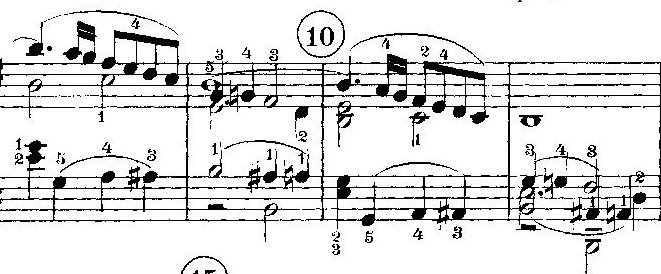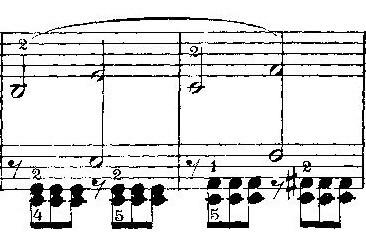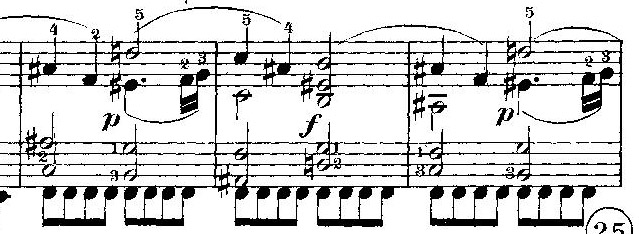A Commentary on our Compositional Technique use for Pond
We provide here an analysis of our work for solo trombone entitled "Pond" which includes a description of our working methods when we created it. "Pond" uses material inspired by Japanese shakuhachi music cast in a sonata allegro form related to Beethoven's Piano Sonata Number 9 (Opus 14 Number 1.) Our inspiration for the shakuhachi music was taken from a recording of "A Bell Ringing In An Empty Sky" made by Goro Yamaguchi in 1969.
Analysis. We began creating a series of formulas that symbolized the structure of Beethoven's Piano Sonata No. 9, and then placed materials related to shakuhachi music into those formulas. In the series of excerpts below, we show the principle motives of the piano sonata's exposition, and the corresponding material from "Pond." At the bottom of this webpage we then include the formulas that define the A section of the piano sonata and explain how the formulas are read.
The scores. It is advisable to also look at the full scores of each work. The excerpts below from the piano sonata are taken from the Heinrich Schenker edition which can be download for free here. And you can download a score of "Pond" here free of charge.
Recordings. A recording of Beethoven's Opus 14 Number 1 can be found here. A recording of "Pond" by Abbie Conant is here. An MP3 recording of "A Bell Ringing In An Empty Sky" can be listen to here.
The A Section's opening motive.
|
To begin, this is the A section of Beethoven's Op. 14, No. 1. (measures 0-4.)
First Part Second Part
|
|
We created a vaguely similar melodic contour form to create the opening motive of Pond, but we broke the four measures into two more distinctly antecedent and consequent phrases. (mea. 1-4)
First Part Second Part
|
Episodic Interlude after the statement of the A section
|
After opening with the main A section, Beethoven inserts two measures of episodic material. (measures 4-6)
|
|
Pond: We include a similar two measure episode, using the same pattern of a two beat figure sequenced four times. (mea. 5-6)
|
The Second motive of the A Section (antecedent phrase)
|
Beethoven introduces a second motive to the A Section. (measure 6-7)
|
|
Pond: We do the same with a two measure figure instead one, but there is a similar rhythmic feel and upward movement of the melody. (mea. 7-10)
|
Second motive of the A Section (consequent phrase)
|
Beethoven used this downward movement to concluded the second motive of the A section. (mea. 8-11)
|
|
Pond: In the same way, we used a very simple downward movement to bring our passage to repose, though our motive contains one measure instead of two. (mea. 11-12)
|
A Section Varied and Repeated
|
Beethoven then restates the opening motive of the A section in a varied form. (mea. 12-15)
|
|
Pond: We also created a varied from of our opening A section motive. Note the similar melodic contour. (mea. 13-15)
|
A Section Varied Consequent phrase
|
Beethoven concludes the varied A section theme with this passage which is played twice. (mea. 16-19)
|
|
Pond: We employ a one measure figure which is also played twice -- the second time transposed. Note the similar rise and then fall of the melodic line. (mea. 16-17)
|
B section
|
Beethoven then states his first motive of the B section which has a scalar character. (mea. 21-25)
|
|
Pond: The opening motive of our B section also focuses on a sort of scalar movement. (mea. 21-24)
|
Second motive of the B section
|
Beethoven later presents a second motive to the B section. The motive is stated twice in the first two bars and is followed by two measures that end the phrase. (mea. 38-41)
Antecedent Consequent
|
|
Pond: We also present a new motive played twice followed by two measures that conclude the phrase. Note how the rhythm of the motive is similar to Beethoven's. (The passage is here repeated twice as in the Beethoven's full score.) (mea. 38-43)
|
The Formulas.
William has used this method of composition for many works such as his "Thirty Memos for Piano", and the first movement of "Music for the End of Time." (Both sites have recordings.) "Pond" was written in 1976 and was the first time we used this method. The first movement of "Music for the End of Time" mentioned above came much later and is a much more elaborate and detailed use of this method since William was much more practiced by that point.
He uses a symbol to label all of the motives in a sonata allegro form. Since Arabic numbers, alphabetic letters, and Roman numerals are already used for certain kinds of musical analysis, he uses astrological symbols to label the motives. The symbols below were used for the above piano sonata by Beethoven:

With these symbols, he then creates formulas that provide an overview of the work's structure, including its harmonic changes, octave transpositions, variations, etc. Here are the meanings of the additional symbols" used in the formulas below:
+ Roman numerals indicate harmonic progressions.
+ The lower case "oct" indicates octave transpositions. The Arabic numbers indicate the number of octaves and the up or down arrows the direction of the shift. (A zero indicates the original octave.)
+ The lower case "var" indicates a variation of a motive.
+ The arrow pointing right means a movement to a new key area.
Here are the formulas used to define the A section of the above piano sonata, though a full sonata usually takes about 15 lines:

Translated into everyday language, the first line means that the opening motive of the A section (the circle with a cross in it) is repeated four times through a harmonic progression of I, IV, V, and I. It is then followed by the first episodic material (the crossed h-like symbol) stated in its original octave and then repeated three more times, each time an octave lower.
The second line means that the antecedent phrase of the second theme of the A section (the crescent moon symbol) is stated once and then repeated an octave higher. This is followed by the consequent phrase (the H-like symbol) which is stated and then repeated an octave lower.
The third line means the opening A theme (the circle with a cross) is varied and then repeated as it moves to the secondary dominate. It is then followed by the A section's concluding cadence (the MR-like symbol.)
As you can see, the formulas are much more concise. To create a work, William (or Abbie and William sometimes together for trombone works,) create motives and put them into these formulas. The process is loose and the motives can sometimes be quite different from the models. Sometimes a work remains fairly close to the formulas, but sometimes the entire structure will take off in its own direction and no longer follow the formulas at all.



